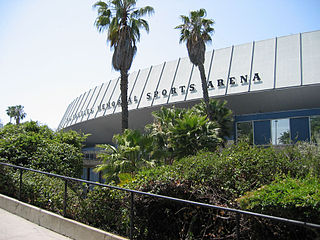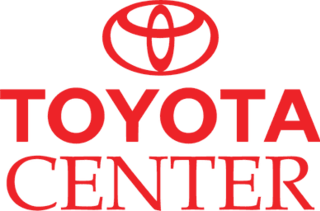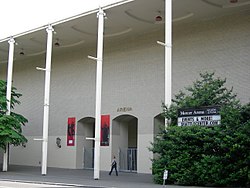
The Century 21 Exposition was a world's fair held April 21, 1962, to October 21, 1962, in Seattle, Washington, United States. Nearly 10 million people attended the fair during its six-month run.
The Colosseum is an elliptical amphitheater in Rome, Italy.

Seattle Center is an entertainment, education, tourism and performing arts center located in the Lower Queen Anne neighborhood of Seattle, Washington, United States. Constructed for the 1962 World's Fair, Seattle Center's landmark feature is the 605 ft (184 m) Space Needle, an official city landmark and globally recognized symbol of Seattle's skyline. Other notable attractions include the Pacific Science Center, Climate Pledge Arena, and Museum of Pop Culture (MoPOP), as well as McCaw Hall, which hosts both the Seattle Opera and Pacific Northwest Ballet. The Seattle Center Monorail provides regular public transit service between Seattle Center and Westlake Center in Downtown Seattle, and is itself considered a tourist attraction.

Climate Pledge Arena is a multi-purpose indoor arena in Seattle, Washington, United States. It is located north of Downtown Seattle in the 74-acre (30 ha) entertainment complex known as Seattle Center, the site of the 1962 World's Fair, for which it was originally developed. After opening in 1962, it was subsequently bought and converted by the city of Seattle for entertainment purposes. From 2018 to 2021, the arena underwent a $1.15 billion redevelopment; the renovation preserved the original exterior and roof, which was declared a Seattle Landmark in 2017 and was listed on the Washington Heritage Register as well as the National Register of Historic Places in 2018. The renovated venue has a capacity of 17,151 for ice hockey and 18,300 for basketball.

Northlands Coliseum is a defunct indoor arena in Edmonton, Alberta, on the north side of Northlands. It was used for sports events and concerts, and was home to the Edmonton Oilers of the World Hockey Association (WHA) and National Hockey League (NHL), and the Edmonton Oil Kings of the Western Hockey League (WHL). The arena opened in 1974, and was later known as Edmonton Coliseum, Skyreach Centre, and Rexall Place, before returning to the Northlands Coliseum name in summer 2016.

The Greensboro Coliseum Complex, commonly referred to as Greensboro Coliseum, is an entertainment and sports complex located in Greensboro, North Carolina. Opened in 1959, the complex holds eight venues that includes an amphitheater, arena, aquatic center, banquet hall, convention center, museum, theatre, and an indoor pavilion. It is the home of the UNC Greensboro Spartans men's basketball team, the Greensboro Swarm of the NBA G League, the Carolina Cobras of the National Arena League, as well as the Atlantic Coast Conference (ACC) with their Men's and Women's basketball tournaments.

The Los Angeles Memorial Sports Arena was a multi-purpose arena at Exposition Park, in the University Park neighborhood of Los Angeles. It was located next to the Los Angeles Memorial Coliseum and just south of the campus of the University of Southern California, which managed and operated both venues under a master lease agreement with the Los Angeles Memorial Coliseum Commission. The arena was closed in April 2016, and was demolished in September of that same year. It was replaced with BMO Stadium, home of Major League Soccer's Los Angeles FC, which opened in 2018.

FirstOntario Centre is a sports and entertainment arena at the corner of Bay Street North and York Boulevard in Hamilton, Ontario, Canada. Opened in 1985, it has a capacity of up to 19,000.

Marion Oliver McCaw Hall is a performing arts hall in Seattle, Washington. Located on the grounds of Seattle Center and owned by the city of Seattle, McCaw Hall's two principal tenants are the Seattle Opera and Pacific Northwest Ballet. The building is named for Marion Oliver McCaw, whose four sons donated $20 million to fund a major renovation in 2003. It was formerly known as the Civic Auditorium and Seattle Opera House.

Coca-Cola Coliseum is an arena at Exhibition Place in Toronto, Ontario, Canada, used for agricultural displays, ice hockey, and trade shows. It was built for the Canadian National Exhibition (CNE) and the Royal Agricultural Winter Fair in 1921. Since 1997 it has been part of the Enercare Centre exhibition complex. It serves as the home arena of the Toronto Marlies ice hockey team, the American Hockey League farm team of the Toronto Maple Leafs. For the 2015 Pan American Games the venue hosted the gymnastics competitions and was known as the Toronto Coliseum.

Barclays Center is a multi-purpose indoor arena in the New York City borough of Brooklyn. The arena is home to the Brooklyn Nets of the National Basketball Association and the New York Liberty of the Women's National Basketball Association. The arena also hosts concerts, conventions and other sporting and entertainment events.

The North Charleston Coliseum is a multi-purpose arena in North Charleston, South Carolina. It is part of the North Charleston Convention Center Complex, which also includes a performing arts center and convention center. It is owned by the City of North Charleston and managed by ASM Global. The coliseum opened in 1993, with the performing arts center and convention center opened in 1999. The complex is located on the access road to the Charleston International Airport.

The luxury box and club seating constitute the most expensive class of seating in arenas and stadiums, and generate much higher revenues than regular seating. Club ticketholders often receive exclusive access to an indoor part of the venue through private club entrances, to areas containing special restaurants, bars, merchandise stands, and lounge areas of the venue that are not otherwise available to regular ticketholders.

Michigan State Fairgrounds Coliseum was a 5,600-seat multi-purpose arena in Detroit, Michigan. The coliseum, built in 1922, was part of the former Michigan State Fairgrounds until its demolition in early 2022. The Michigan State Fair, the oldest state fair in the United States, was held here until 2009. The coliseum has also been the long-time venue of Detroit performances by the Shrine Circus.

The New York Coliseum was a convention center that stood at Columbus Circle in Manhattan, New York City, from 1956 to 2000. It was designed by architects Leon Levy and Lionel Levy in a modified International Style, and included both a low building with exhibition space and a 26-story office block. The project also included the construction of a housing development directly behind the complex.

The Accesso ShoWare Center is a multi-purpose arena in Kent, Washington, United States.

The Toyota Center is a multi-purpose arena in the northwest United States, located in Kennewick, Washington.

True North Sports and Entertainment Limited is a Canadian company based in Winnipeg, Manitoba, that owns and operates Canada Life Centre in downtown Winnipeg and the Winnipeg Jets of the National Hockey League. The company also owns the Jets' minor league affiliate, the Manitoba Moose of the American Hockey League. Aside from hockey, TNSE is also involved in real estate with True North Square, and are active in bringing concerts and other acts to Winnipeg.
Sonics Arena was a proposed multi-purpose arena to be constructed in the SoDo neighborhood of Seattle, Washington, United States. The arena would have hosted basketball, ice hockey, and concerts. The proposal called for an arena with a capacity of around 19,000 to 20,000 seats. It was part of a larger plan to return the Seattle SuperSonics (NBA) franchise, along with adding a potential National Hockey League (NHL) franchise, to the city of Seattle. The proposal was rejected in favor of redeveloping KeyArena into Climate Pledge Arena.

Fiserv Forum is a multi-purpose arena located in downtown Milwaukee, Wisconsin. It is the home of the Milwaukee Bucks of the National Basketball Association (NBA) and the Marquette Golden Eagles men's basketball team of Marquette University.



















